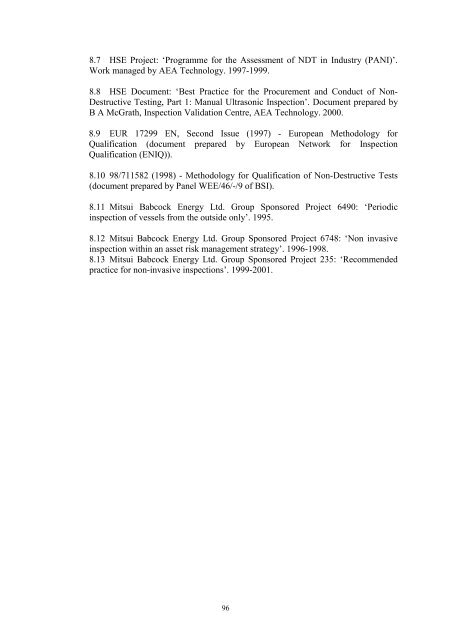Best Practice for Risk Based Inspection
risk based inspection
risk based inspection
You also want an ePaper? Increase the reach of your titles
YUMPU automatically turns print PDFs into web optimized ePapers that Google loves.
a) A Technical Justification, and<br />
b) A Practical Assessment (carried out using a representative test piece(s))<br />
Two documents are in existence that can be used as a basis <strong>for</strong> the development of<br />
inspection qualification programmes. One is a European document (8.9) developed<br />
by ENIQ, the European Network <strong>for</strong> <strong>Inspection</strong> Qualification. This document is<br />
widely used within the nuclear industry both in the UK and in Europe. The other is<br />
a BSI document (8.10) that used the ENIQ document as a basis <strong>for</strong> its development.<br />
This document is aimed at the non-nuclear industry.<br />
8.4.2. Technical Justification<br />
A Technical Justification is a collection of in<strong>for</strong>mation that provides evidence of<br />
inspection capability. The Technical Justification might include physical reasoning<br />
(inc. identification and discussion of the essential parameters of the inspection),<br />
mathematical modelling and inspection results.<br />
The Technical Justification should identify ‘worst-case’ defects, i.e. defects judged<br />
to be the most difficult to detect and size at specific locations.<br />
8.4.3. Practical Assessment<br />
A Practical Assessment involves the conduct of trials on a test piece(s)<br />
representative of the component, and provides a demonstration of inspection<br />
capability. Material composition, size/geometry and the defective condition of the<br />
component should be represented. The population of the test piece(s) should include<br />
‘worst-case’ defects.<br />
Test piece trials to prove the capability of the inspection procedure should normally<br />
be carried out ‘open’, i.e. the personnel involved in the trials having specific<br />
knowledge of the defects contained in the test piece(s).<br />
Test piece trials to assess the capability of the inspection personnel, to apply the<br />
proven procedures correctly under realistic conditions, should normally be carried<br />
out ‘blind’, i.e. the personnel involved in the trials having no specific knowledge of<br />
the defects contained in the test piece(s).<br />
The combination of theoretical evidence and practical demonstration provides<br />
powerful confirmation that the inspection is capable of achieving the required<br />
per<strong>for</strong>mance. The mix of the two depends on the inspection being qualified and the<br />
level of qualification (see Section 8.4.4). In general, the more straight<strong>for</strong>ward the<br />
inspection the more practically biased the mix; the more complicated the inspection<br />
the more equal the mix.<br />
8.4.4. Qualification Level<br />
The level of rigour is a matter to be agreed between the different parties involved<br />
(plant owner/operator, regulatory body etc). More often than not, the safety and/or<br />
economic consequences of component failure are the major factors in determining<br />
the level of rigour required.<br />
92



